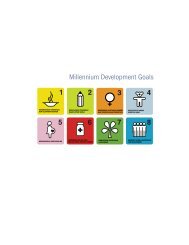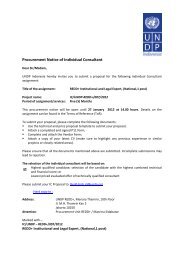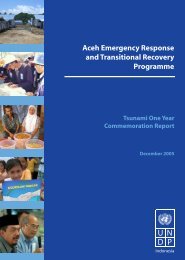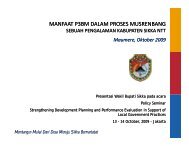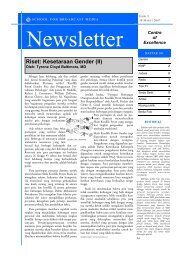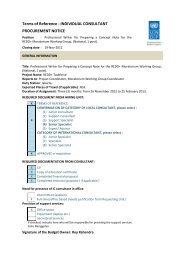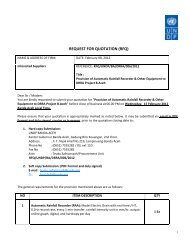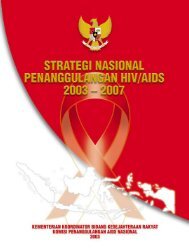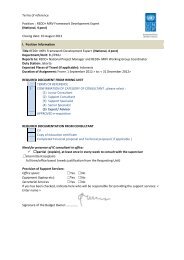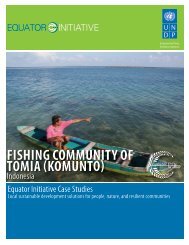Papua Needs Assessment - UNDP
Papua Needs Assessment - UNDP
Papua Needs Assessment - UNDP
Create successful ePaper yourself
Turn your PDF publications into a flip-book with our unique Google optimized e-Paper software.
5.2 Health<br />
Health standards in <strong>Papua</strong> are considerably worse than in other parts of Indonesia. The infant<br />
mortality rate of 50.5 infant deaths per 1000 is higher than that of Indonesia as a whole at 43.5<br />
(Indonesia Human Development Report 2004). The maternal mortality rate is 1,116 per 100,000<br />
births, which is the highest in Indonesia, (Provincial Health Service data, 2005). These statistics<br />
are indicators of the general health of the population. Among the most serious contributors to<br />
these health risks are communicable and sanitation-related illnesses, such as malaria and<br />
tuberculosis.<br />
Besides endemic malaria and tuberculosis in many areas, <strong>Papua</strong> is also subject to the emerging<br />
threat of HIV/AIDS. This disease is spreading within the general public infecting a reported<br />
14,392 cases, divided roughly equally among women and men (<strong>Papua</strong> Government Health Service<br />
Data, 2005). The estimated number of cases and infection rates are considered likely to be the<br />
highest in Indonesia, due to a combination of factors relating to low levels of health and education,<br />
prevalent social norms and practices, and the high number of mobile workers in <strong>Papua</strong>. The<br />
pattern of HIV/AIDS that seems to be emerging there, while not yet confirmed via rigorous<br />
epidemiological research, resembles the explosive transmission patterns that have ravaged some<br />
African nations.<br />
According to estimates from the Government Health Service in <strong>Papua</strong> (2003), 68% of HIV infected<br />
people are indigenous <strong>Papua</strong>ns, 22% are non-<strong>Papua</strong>n and 10% are in high risk groups, such as<br />
sex workers and their customers. With the expansion of the mining, oil and timber industries, as<br />
well as the arrival of security forces in large numbers, many isolated areas in <strong>Papua</strong> have developed<br />
an accompanying sex industry. Going forward, the sex industry is thus a likely accelerant of HIV<br />
infections as the industry continues to prosper. However, risky sexual behaviour in general (such<br />
as starting sexual activities at a relatively young age and frequently changing partners) and is<br />
responsible for over 90% of HIV/AIDS infections in <strong>Papua</strong>.<br />
To respond to these challenges, the health service systems must also overcome geographic and<br />
resource constraints, such as insufficient budgets, expertise and general infrastructure for<br />
distributing medicines and equipment. Similar to the education sector, health has been identified<br />
by government as a priority sector, but this policy has not translated into larger budget allocations.<br />
In the provincial government budget of 2002, only 8% was allocated to health and only 2% of the<br />
city / kabupaten government budgets (Provincial Government Budget, 2002). Health facilities<br />
have been built, but in particular in the rural and remote areas they are often without medical staff,<br />
equipment and medicines. The ratio of medical staff per population in the different kabupatens<br />
varies greatly, from 1 doctor per 2000 to 1 per 23000 people; and 1 paramedic per 200 to 1 per 500<br />
people (PNA report, 2005). Again, as with the education sector, religious organisations provide<br />
some basic services in parallel with government in some areas, and alone in other areas where<br />
the government is not present. Their human and financial resources are limited, but they do have<br />
appear to be trusted by communities.<br />
The majority of mobile community health centres or Puskesmas (four wheel drive vehicles/small<br />
water-craft) cover districts (kecamatan) where transport and communication conditions are<br />
treacherous. Thus many remote areas do not have enough access to these health centers<br />
because of the expensive fuel costs required to reach remote areas. Some remote areas can<br />
only be reached by motor bikes and reaching those areas in the wet season makes the cost of<br />
health services very expensive. The situation is agravated by the scattered populations of very<br />
small villages, for example Waropko District which has a total population of 2,980 people spread<br />
over 16 villages.<br />
When in need of medicine, the majority (65%, according to Dinas Kesehatan, 2005) of the<br />
population of <strong>Papua</strong> go to the nearest Community Health Centres (Puskesmas). These are often<br />
23



